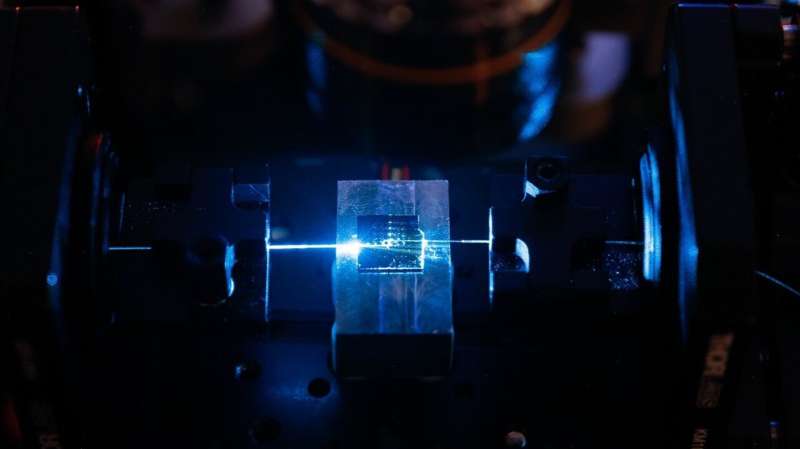This article has been reviewed according to Science X's editorial process and policies. Editors have highlighted the following attributes while ensuring the content's credibility:
fact-checked
peer-reviewed publication
trusted source
proofread
Researchers fabricate chip-based optical resonators with record low UV losses

Researchers have created chip-based photonic resonators that operate in the ultraviolet (UV) and visible regions of the spectrum and exhibit a record low UV light loss. The new resonators lay the groundwork for increasing the size, complexity and fidelity of UV photonic integrated circuit (PIC) design, which could enable new miniature chip-based devices for applications such as spectroscopic sensing, underwater communication and quantum information processing.
"Compared to the better-established fields like telecom photonics and visible photonics, UV photonics is less explored even though UV wavelengths are needed to access certain atomic transitions in atom/ion-based quantum computing and to excite certain fluorescent molecules for biochemical sensing," said research team member Chengxing He from Yale University. "Our work sets a good basis toward building photonic circuits that operate at UV wavelengths."
In Optics Express, the researchers describe the alumina-based optical microresonators and how they achieved an unprecedented low loss at UV wavelengths by combining the right material with optimized design and fabrication.
"Our work demonstrates that UV PICs have reached a critical point where light loss for waveguides is no longer significantly worse than their visible counterparts," said Hong Tang, leader of the research team. "This means that all the interesting PIC structures developed for visible and telecom wavelengths, such as frequency combs and injection locking, can be applied to UV wavelengths as well."
Decreasing light loss
The microresonators were made from high quality alumina thin films that co-authors Carlo Waldfried and Jun-Fei Zheng from Entegris Inc. prepared using a highly scalable atomic layer deposition (ALD) process. Alumina's large bandgap of ~8eV makes it transparent to UV photons, which have a much lower (~4eV) energy than the bandgap. Thus, UV wavelengths are not absorbed by this material.
"The previous record was accomplished with aluminum nitride, which has a bandgap of ~6eV," He said. "Compared to single crystal aluminum nitride, amorphous ALD alumina has fewer defects and is less challenging to fabricate, which helped us to achieve lower loss."
To create the microresonators, researchers etched the alumina to create what is commonly known as a rib waveguide, in which a slab with a strip on top creates the light-confining structure. As the rib becomes deeper, the confinement becomes stronger but so does the scattering loss. They used simulation to find just the right etch depth to achieve the light confinement needed while minimizing the scattering loss.
Making ring resonators
The researchers applied what they learned from waveguides to create ring resonators with a 400-micron radius. They found that the radiation loss can be suppressed to less than 0.06 dB/cm at 488.5 nm and less than 0.001 dB/cm at 390 nm when the etch depth was more than 80 nm in a 400-nm thick alumina film.
After fabricating ring resonators based on these calculations, the researchers determined their Q factors by measuring the width of resonance peaks while scanning the light frequency injected into the resonator. They found a record-high quality (Q) factor of 1.5 × 106 at 390 nm (in the UV portion of the spectrum) and a Q factor of 1.9 × 106 at 488.5 nm (a wavelength for visible blue light). Higher Q-factors indicate less light loss.
"Compared to PICs in visible or telecom wavelengths, UV PICs may find an edge in communications due to the larger bandwidth or in conditions where other wavelengths get absorbed, such as underwater," said He. "Also, the fact that the atomic layer deposition process used to create the alumina is CMOS compatible paves the way for CMOS integration with amorphous alumina-based photonics."
The researchers are now working to develop alumina-based ring resonators that can be tuned to work with different wavelengths. This could be used to achieve precise wavelength control or to create modulators by using two resonators that interfere with each other. They also want to develop a PIC-integrated UV light source to form an entire PIC based UV system.
More information: Chengxing He et al, Ultra-high Q alumina optical microresonators in the UV and blue bands, Optics Express (2023). DOI: 10.1364/OE.492510
Journal information: Optics Express
Provided by Optica





















